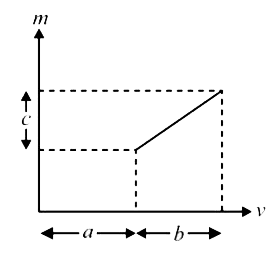Two thin converging lenses are placed on a common axis, so that the centre of one of them coincides with the focus of the other. An object is placed at a distance twice the focal length from the left hand lens. Where will its image be? What is the lateral magnification? The focal of each lens is f.
The correct Answer is:A, B
To solve the problem step by step, we will analyze the situation with two converging lenses placed on a common axis, with the center of one lens coinciding with the focus of the other.
Step 1: Understand the Configuration
We have two converging lenses, both with a focal length f. The first lens has an object placed at a distance of 2f from it. The second lens is positioned such that its center coincides with the focus of the first lens.
Step 2: Determine Object Distance for the First Lens
The object distance u1 for the first lens is given as:
u1=−2f
(Note: The negative sign indicates that the object is on the same side as the incoming light.)
Step 3: Use the Lens Formula for the First Lens
The lens formula is given by:
1f=1v−1u
For the first lens, substituting u1 and f:
1f=1v1−1−2f
This simplifies to:
1f=1v1+12f
Combining the terms gives:
1v1=1f−12f=2−12f=12f
Thus, we find:
v1=2f
Step 4: Calculate Magnification for the First Lens
The magnification m1 for the first lens is given by:
m1=−v1u1=−2f−2f=1
Step 5: Determine Object Distance for the Second Lens
The image formed by the first lens acts as a virtual object for the second lens. The distance from the first lens to the second lens is f (the focal length of the first lens). Therefore, the object distance u2 for the second lens is:
u2=−f
Step 6: Use the Lens Formula for the Second Lens
Using the lens formula again for the second lens:
1f=1v2−1u2
Substituting u2:
1f=1v2−1−f
This simplifies to:
1f=1v2+1f
Rearranging gives:
1v2=0⟹v2=∞
This indicates that the image formed by the second lens is at infinity.
Step 7: Calculate Magnification for the Second Lens
The magnification m2 for the second lens is given by:
m2=−v2u2=−∞−f=∞
Step 8: Calculate Total Magnification
The total magnification m is the product of the individual magnifications:
m=m1×m2=1×∞=∞
Final Result
The final image is formed at infinity, and the lateral magnification is also infinite.
We have two converging lenses, both with a focal length f. The first lens has an object placed at a distance of 2f from it. The second lens is positioned such that its center coincides with the focus of the first lens.
The object distance u1 for the first lens is given as:
u1=−2f
(Note: The negative sign indicates that the object is on the same side as the incoming light.)
The lens formula is given by:
1f=1v−1u
For the first lens, substituting u1 and f:
1f=1v1−1−2f
This simplifies to:
1f=1v1+12f
Combining the terms gives:
1v1=1f−12f=2−12f=12f
Thus, we find:
v1=2f
The magnification m1 for the first lens is given by:
m1=−v1u1=−2f−2f=1
The image formed by the first lens acts as a virtual object for the second lens. The distance from the first lens to the second lens is f (the focal length of the first lens). Therefore, the object distance u2 for the second lens is:
u2=−f
Using the lens formula again for the second lens:
1f=1v2−1u2
Substituting u2:
1f=1v2−1−f
This simplifies to:
1f=1v2+1f
Rearranging gives:
1v2=0⟹v2=∞
This indicates that the image formed by the second lens is at infinity.
The magnification m2 for the second lens is given by:
m2=−v2u2=−∞−f=∞
The total magnification m is the product of the individual magnifications:
m=m1×m2=1×∞=∞
The final image is formed at infinity, and the lateral magnification is also infinite.
Topper's Solved these Questions
- REFRACTION OF LIGHTBOOK - DC PANDEY ENGLISHCHAPTER - REFRACTION OF LIGHTEXERCISE - Exercise 31.1
3 Videos
- REFRACTION OF LIGHTBOOK - DC PANDEY ENGLISHCHAPTER - REFRACTION OF LIGHTEXERCISE - Exercise 31.2
2 Videos
- REFRACTION OF LIGHTBOOK - DC PANDEY ENGLISHCHAPTER - REFRACTION OF LIGHTEXERCISE - Example Type 11
3 Videos
- REFLECTION OF LIGHTBOOK - DC PANDEY ENGLISHCHAPTER - REFLECTION OF LIGHTEXERCISE - Subjective
9 Videos
- SEMICONDUCTORSBOOK - DC PANDEY ENGLISHCHAPTER - SEMICONDUCTORSEXERCISE - Subjective
12 Videos
Similar Questions
Knowledge Check
An object is placed at a distance of 1.5m from a screen and a convex lens is interposed between them. The magnification produced is 4. What is the focal length of the lens ?
A1mB0.5mC0.24mD2m
An object is placed at a distance of 12 cm from a convex lens of focal length 8 cm. Find :
nature of the image
View SolutionAn object is placed in front of a converging lens at a distance greater than twice the focal length of the lens. Draw a ray diagram to show the formation of the image.
View SolutionWhen an object is at distances x and y from a lens, a real image and a virtual image is formed respectively having same magnification. The focal length of the lens is
View SolutionAn object is placed at a distance of 12 cm from a convex lens of focal length 8 cm. Find :
the position of the image
View SolutionAn object is placed at a distance 24 cm in front of a convex lens of focal length 8 cm.
Calculate the distance of the image from the lens.
View SolutionAn object is placed at a distance u from an equiconvex lens such that the distannce between the object and its real image is minimum. The focal length of the lens is f. The value of u is
View SolutionThe graph shows how the magnification m produced by a thin lens varies with image distance v. What is the focal length of the lens used?

View Solution
